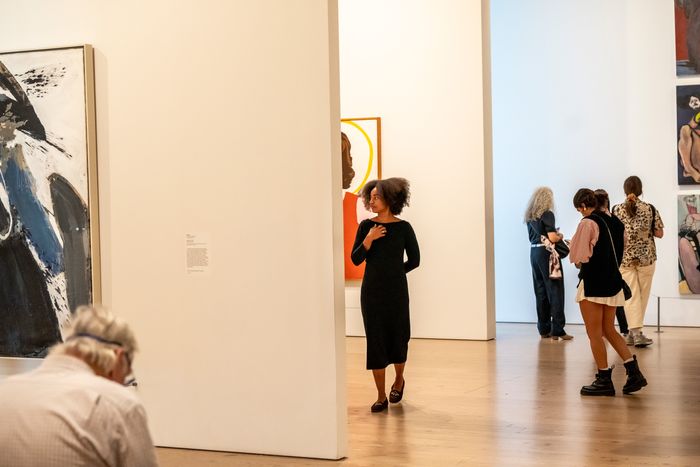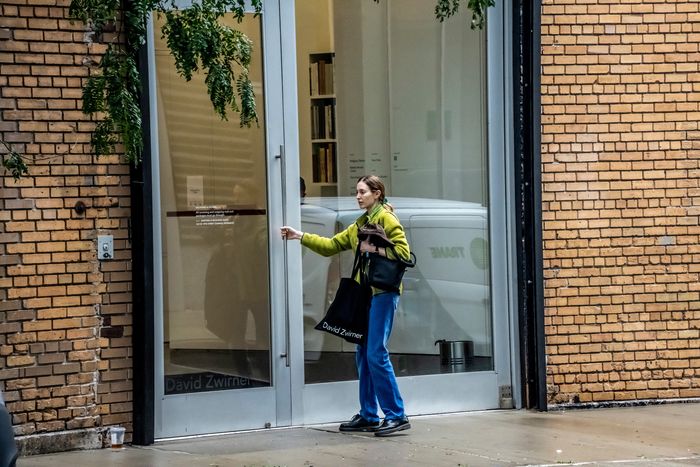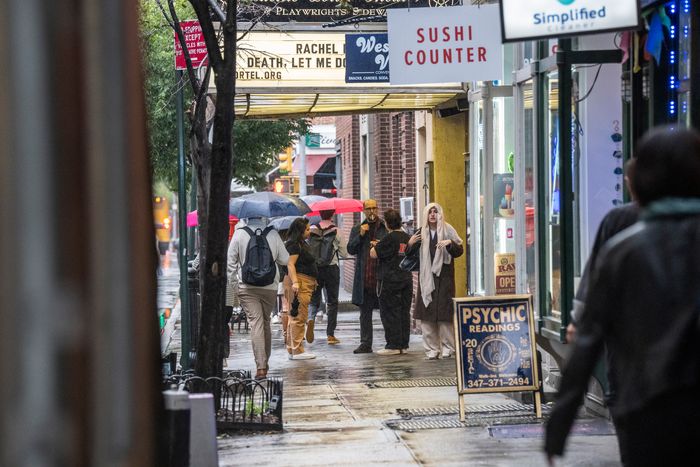
You may have seen that we published a list of 49 exceptionally powerful New Yorkers whose names you’ve likely never heard. You can call theirs inside power, hidden power, stealthy power — but in every case, what they wield is a distinct, sometimes frightening ability to get things done in their respective universes. Here’s a look at all the cultural power players from our list, from one very under-the-radar art collector to Reese Witherspoon’s publishing mole to the producers who can propel a stand-up comedian’s tight-15 into a Netflix hit.
The Power To:
Put an Artist in the Right Collection (His)
Watch what A.C. Hudgins buys. Its value will probably multiply.
A.C. Hudgins, who made his fortune in finance, has been collecting art since the 1970s, championing Black artists like Henry Taylor and Senga Nengudi when they were still being ignored by most white gallerists. Take, for example, his early interest in the artist David Hammons, whose work shocked viewers by using materials like gnawed ribs, barbershop hair clippings, and grease-stained paper bags. Now a piece by Hammons goes for millions. As a result of these bets, Hudgins “has one of the most formidable collections of Black art of any American collector,” one gallerist told me, and his predilections continue to carry a strong signal for the rest of the art world. “Somebody like A.C. is probably one of the most important in the ecosystem,” says one dealer I spoke with, “because if he finds a young artist that he believes in, it can be a seal of approval.” His name has become a “shorthand for taste,” says the gallerist.
Hudgins has helped shape the collections of some of the city’s most prestigious galleries and museums. As a member of the MoMA board since 2012, he’s advocated for more members of color and diversified the museum’s curation. (MoMA now has the most significant collection of Hammons’s work, about a third of which was donated by Hudgins.) But despite being entrenched in the art Establishment, Hudgins, people repeatedly say, collects for the “right reasons.” “He’s not a flipper. I don’t think he resells art, which we love,” says the dealer. Instead, Hudgins develops relationships with artists; hosts them at his home; and becomes involved in their creative process. “It’s an investment that transcends the financial transaction,” says a New York–based curator. “It’s very rare for collectors to be interested at that level.” His firmly held opinions and eccentric sense of humor — “I’m Negro rich, not MoMA rich,” he told the New York Times in 2016 — allow him to move between highbrow and grassroots artistic spaces. Today, the collector regularly scouts galleries, loans his art to curators, and is hungry to learn about new talent, which has maintained his relevance among the newest generation of artists. “He was serious about knowing who I was and what I was making,” one young California-based artist remembers. “Much earlier than so many other people.” — Angelina Chapin
The Power To:
Make the Whitney Less White
Rujeko Hockley is changing the museum.
Rujeko Hockley was not hired solely to make the Whitney’s collections less white. There was no job description that read “curator of contemporary Black art,” says Scott Rothkopf, the museum’s incoming director. But since joining the institution in 2017, Hockley has helped expand the artists of color acquired and promoted by the museum, advocating for people like Toyin Ojih Odutola, Julie Mehretu, and Dindga McCannon. “She’s part of a group of Black woman curators who have laid the groundwork, quietly and without fanfare, that a lot of artists are standing on now,” says the artist Simone Leigh, who was part of the 2019 Whitney Biennial, co-curated by Hockley, that showcased a majority of works by non-white artists.
Cover Story
Much of Hockley’s success derives from her deftness. “It’s not like a bulldozer of confidence but a more subtle kind of vehicle that’s classy and stylish, like a Cadillac,” says the artist Sadie Barnette. Since Hockley was hired, the Whitney has promoted more non-white staffers and now has four curators of color. But it has also been the subject of controversies around racially charged art, such as the inclusion of Dana Schutz’s Open Casket in the 2017 biennial. Throughout heated staff conversations, Hockley displayed a knack for “meeting people where they are without making them feel stupid,” Rothkopf says. Instead of arguing that museums need to include X number of Black artists in their collections to meet a quota, the artist Linda Goode Bryant says, Hockley encourages her colleagues “to be curious, and to explore things that may be overlooked and ignored.” And artists trust Hockley’s feedback. “There’s a way in which the art world expects people to have a certain meanness,” says Leigh. “Normally when people are razor sharp, they’re just not able to be as kind as she is.” — Angelina Chapin
The Power To:
Inherit a Megagallery (Maybe)
Of the Zwirner children working in their father’s empire, Lucas is front and center. Then there’s Marlene Zwirner.
The eldest child of the art dealer David Zwirner is the best known of his three children, apparently because he likes it that way. Lucas, 32, has hosted the gallery’s official podcast and fashioned himself as a publishing impresario, driving the gallery’s underwriting of The Drift and overseeing its book series “ekphrasis.” His square, action-hero jaw shows up alongside glamorous actresses (Sienna Miller, Jessica Joffe), and rumors about him and Dianna Agron led to more rumors about why the painter Harold Ancart, Agron’s boyfriend, left for Gagosian.
By contrast, there’s Marlene, 30. Even people who say they know “the siblings” admit they don’t know “Marl” as well. She’s been tagged in a grand total of three pictures on the party website BFA compared to Lucas’s 23. Marlene does the behind-the-scenes labor that allows the gallery to function. As a sales director, she manages artists like Katherine Bernhardt, Joe Bradley, Roy de Carava, Shio Kusaka, Josh Smith, and the estate of Noah Davis, and her power derives from their loyalty. The sculptor Andra Ursuta credits Marlene with the gallery’s decision to take her on, though “obviously she would never take credit for it.” This year, when Ursuta suggested a show in London, Marlene “immediately pulled out her phone to look at the schedule,” and voilà: “She does everything with a light touch.”
“People choose who they surround themselves with, and Marlene surrounds herself with artists,” says her friend Ellie Rines, who runs the gallery 56 Henry. “She’s like an artist whisperer.” Josh Smith had been looking for a change when Marlene introduced him to her then-boyfriend, the Givenchy designer Matthew M. Williams. They collaborated on a collection that had the sculptor carrying luxury handbags and Kid Cudi wearing Josh Smith.
At the same time, Marlene seems careful not to mix work and play. Neither of her painter exes, Lucien Smith and Dan Colen, is at Zwirner; though she’s now dating Matthew Brown, the precocious, 20-something gallerist, the two aren’t snapped together on red carpets. “I’ve never met anyone like Marlene,” says Josh Smith, who homed in on her rarest of qualities. “She doesn’t like being the center of attention.” — Adriane Quinlan
Correction: A previous version of this story incorrectly attributed a quote by Josh Smith.
The Power To:
Launch an Art Star
The megagalleries are always after Ellie Rines’s finds.
The veteran art dealer Jeffrey Deitch is always on the lookout for young gallerists. “I heard about this woman in this tiny storefront and that she lived in the back of the gallery, and I was intrigued,” he says. So a few years ago he visited Ellie Rines at her 450-square-foot gallery, 56 Henry. “I walked over and I saw this phenomenal show of Anna Weyant,” who had just graduated from RISD. “I said, ‘This is terrific. Can I buy one?’ But everything was sold. Unlike other galleries, which ignore you or play games, shortly after that opening, she called me and said, ‘I have a painting for you.’ It was marvelous, and I acquired it for something like $6,000. And through that we made a rapport.”
The 35-year-old owner of the teensy gallery — she no longer sleeps in its back room — has managed to find and launch the careers of Al Freeman, Nikita Gale, Cynthia Talmadge, and Weyant, among others. In a world defined by megagalleries, Rines punches above her square footage.
“Art bros try to seduce the artists I show into their programs with larger spaces or promises of more money,” Rines says of the megas. Weyant and Gale have been lured away; others are being courted. “I often have to be on the defense,” she says, “and do all this weird shit to keep the artists happy.” Last year, she opened a second space at 105 Henry (it’s 550 square feet) and now shows at the Armory Show and Art Basel Miami Beach. It helps that cool people like her; you might run into Maurizio Cattelan, Venus Williams, Cat Power, or Lily-Rose Depp in the bedroom turned VIP lounge at Rines’s gallery. “She’s really part of the whole process of how art enters into the culture,” says Deitch. “The art world can’t develop artists and collectors without people like Ellie.” — Michael Slenske
The Power To:
Propel Comedians Onto Netflix
Mike Lavoie and Carlee Briglia have charted a path from small theater to Broadway to beyond.
Roughly speaking, there are now two ways for a comic to break out of the New York scene. The first is to relentlessly post stand-up clips to social media until you build an audience big enough to justify a tour. The second is to workshop an ambitious solo show with a cohesive theme and theatrical-production value, hoping to turn it into a critical darling and, eventually, a highly paid special on Netflix. The latter track is more demanding and prestigious, and the producers who best know how to steer comedians through it are Mike Lavoie and Carlee Briglia.
“All people ever ask me about is ‘How can I get in touch with Mike and Carlee?’” says Alison Leiby, who worked with them on her hit 2022 production, Oh God, a Show About Abortion. “They’re so big and they’re so important and nobody outside comedy knows it,” says Alex Edelman, whose show Just for Us Lavoie and Briglia produced. Of the 18 shows Lavoie and Briglia have staged for extended runs, one has been turned into a major movie, three have advanced from Off Broadway to Broadway, and ten have gone on to become specials on Netflix and HBO.
Lavoie went to Georgetown with Mike Birbiglia, where they both performed on the improv team. In 2008, he worked as a producer on Birbiglia’s pioneering solo show Sleepwalk With Me, and a few years later began teaming up with Briglia, a fellow Georgetown graduate. (They’re aware that the similar names are confusing.) Their company, Mike & Carlee Productions, has backed hits by Neal Brennan (3 Mics), John Mulaney and Nick Kroll (Oh, Hello Live), Chris Gethard (Career Suicide), Jacqueline Novak (Get on Your Knees), and Kate Berlant (Kate), among others.
In their niche, Lavoie and Briglia have a reputation for low-key competence and profitability. They connect talent to investors, venues, and technicians; they also manage the comics’ neuroses, so they stay at ease while running shows that are orders of magnitude more complicated than performing a set at the Comedy Cellar. “They have a wry sense of humor,” says Colin Quinn, who has worked with the pair on at least five productions. “They’re so used to being around the comedy space, and they understand that talking to comedians is different from talking to actors.” — Hershal Pandya
The Power To:
Keep Broadway’s Lights On
Theater landlord Bob Wankel can prop up a struggling musical — and maybe an entire industry.
The best way to semi-reliably make money on Broadway is to own a Broadway theater, and the Shubert Organization has 17 of them, far more than any other entity. Among them are several of the most desirable big houses for musicals, such as the Winter Garden and the Majestic. That puts a whole lot of cards in the hand of Bob Wankel, Shubert’s CEO. He doesn’t seem to make decisions based on individual taste: No one on Broadway could tell you what a Shubert show looks or sounds like. But he has an eye for what can turn a profit and the patience to wait out a slow start — a combination that has, in turn, helped Broadway survive the jitters of the post-pandemic recovery.
Productions pay theater-operating expenses and a base rent that is a percentage of the gross, so a big success is in the landlord’s interest as well as a producer’s. Because baseline costs are more or less fixed once a show is up, a hit or a flop is immediately obvious. (Say a musical costs $850,000 per week to run and ticket sales are $300,000. It’ll be gone fast.) If a show is struggling to break even, a theater owner has a choice: Let it close and hope the next show does better, or bet on what you have by forgoing a portion of the rent in the belief that it will eventually turn the corner. Wankel, who has been with Shubert since 1975, is understandably cagey about which shows have seen such reductions, but he’s candid in general. “When a show’s in trouble, we’re the first ones to reduce the rent,” he says. “It’s in our interest for you to become successful.”
This year, even big reliable moneymakers (Hamilton, The Book of Mormon) are taking in less than they did before. New musicals have had an even tougher time. A lot of tickets are being bought at the last minute, steeply discounted. The well-received Here Lies Love, at the Shubert-owned Broadway Theatre, had seating, and thus sales, reduced to make room for a big dance floor; some weeks nearly a third of the house has been unsold. Broadway insiders chatter that a Wankel-authorized rent reduction is the sole factor keeping shows like this from folding.
The Shubert Organization is owned by a nonprofit, so Wankel doesn’t have to worry about pleasing financiers looking for immediate returns. The renovation of the James Earl Jones Theatre a couple of years ago, Wankel says with pride, cost $57 million. Will the company ever see that money back? “Someday — I hope,” he says. “Theater owners have the loooong-term view.” — Christopher Bonanos
The Power To:
Get It All to Reese Witherspoon
Her book club mints best sellers. Jon Baker is one of her scouts.
When Reese Witherspoon started Reese’s Book Club in 2017, modeled on Oprah’s, she needed someone to ferret out the books that she would recommend. Among those her team hired was a book scout named Jon Baker. Scouts are professional gossips and tastemakers who look for interesting manuscripts and books from one market and recommend them to publishers in others. Baker scouts from Jersey City for Bloomsbury U.K., Albin Michel in France, and other clients. But what distinguishes him is that “he decides which book reaches Reese’s beach house,” as one book exec puts it. Baker and his team read everything with an eye for Witherspoon’s tastes — she seems to have a fondness for women-in-peril reads — then present her with a shortlist. Baker’s suggestions — such as Elif Shafak’s The Island of Missing Trees and Andrea Bartz’s We Were Never Here — tend to end up club picks. Witherspoon’s and other celebs’ book clubs feed the best-seller list and make many a novelist’s career. But gaining Witherspoon’s favor has a bonus feature: Many of her selections — Daisy Jones & the Six, Where the Crawdads Sing, and Little Fires Everywhere — were later adapted for the screen by her production company, Hello Sunshine. — Shawn McCreesh
The Power To:
Mainstream the Queerest Manuscripts
Jackson Howard got a book narrated by a queer mountain lion published by FSG.
There’s a certain type of book that’s becoming known as Jackson Howard’s genre: queer, experimental, and generally difficult to get past the fusty old guard of publishing. The 29-year-old editor’s power is that he manages to get them past. His greatest career success so far may have been with the writer Brontez Purnell, who won a Whiting Award for his second book, Since I Laid My Burden Down. Purnell’s follow-up: the scandalously vivid, extremely well-reviewed 100 Boyfriends. “Without even knowing me, Jackson was like, ‘Come to New York and crash on my couch,’” the author says. “I was basically told that FSG had never put out a book like 100 Boyfriends, and he went to bat for me. My babies — as I like to refer to my books — finally had a good father to help raise them.” “He’s tenacious at every stage,” says Purnell’s agent, Julia Masnik. Masnik was introduced by Howard to two writers who are now her clients, one of whom, Imogen Binnie, was recently republished by Howard. Sarah Schulman, whose history of ACT UP was edited by Howard, recommended him to Judith Butler, who now works with him. He recently managed to get a book published — Open Throat, by Henry Hoke — whose protagonist is a queer mountain lion. Howard, for his part, feels his marketing genius and vast social network are crucial to the equation: “Bowen Yang loves reading all my books. And I can send my books to Robyn, the singer.” According to Catherine Lacey, who will soon publish her sixth book with Howard, “what Jackson brings is ‘How can we make this work scrutable to people that are maybe not complete fucking nerds?’” — Emily Gould
The Power To:
Start a Bidding War for a Book
Now that she has secured deals for Clint Smith and Nikole Hannah-Jones, publishers trust Alia Hanna Habib’s taste.
When a submission comes in from her, you stop what you’re doing,” says Doubleday senior editor Yaniv Soha of Alia Hanna Habib. The 45-year-old agent possesses the rare ability to start a bidding war just by sending over a manuscript.
The world of literary agents can be confusing for authors and editors both. There are powerful reps who can offer connections to film and television but who might be less interested in the literary potential of the text. There are boutique agencies that offer their clients more focused attention and passion but might lack the oomph to get their authors big deals. Habib is at a midsize agency (the Gernert Company), which means she has leverage in negotiations as well as an elite list of mostly nonfiction authors. This she managed by taking on clients early in their careers and convincing publishers to trust her taste. Sometimes on the basis of just one excellent article or small-press book, Habib started turning semi-unknowns into household names, like Clint Smith, Hanif Abdurraqib, Merve Emre (whom Habib has represented since her essay on female sociopaths was published on Digg), and Nikole Hannah-Jones, whom she nabbed pre–“1619 Project.”
Random House’s Hilary Redmon, who won the 18-bidder deal that brought in Smith’s next three books, says Habib is on a shortlist of agents whose projects she prioritizes automatically: “She’s one of the top-five people
I would read anything from immediately.” Dan Gerstle, the editor-in-chief of Norton, agrees. “In the last five-to-seven years, she’s become one of the few agents who is determining what people in this country read.”
Her reputation pays off for her writers in other ways. “She’s willing to do things like strongly request that we renegotiate a contract for an author whose platform has expanded since the book was acquired,” says Soha. “She may not get what she wants every time, but you have to take the request seriously when it comes from her. You know what I mean? Another agent, you might turn it down out of hand — but this is Alia.” — Emily Gould









